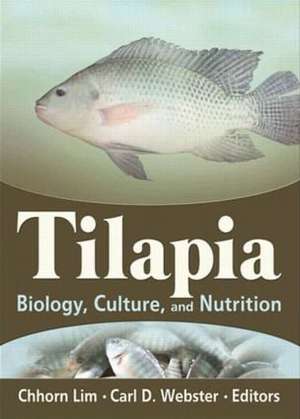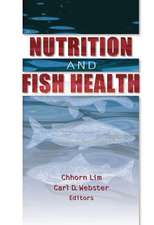Tilapia: Biology, Culture, and Nutrition
Editat de Carl D Webster, Chhorn Limen Limba Engleză Paperback – 21 aug 2006
Tilapia is the second-most cultured fish species in the world, and its production is increasing each year. However, for several reasons profit margins remain slim. Tilapia: Biology, Culture, and Nutrition presents respected international experts detailing every aspect of tilapia production around the world. Biology, breeding and larval rearing, farming techniques, feeding issues, post-harvest technology, and industry economics are clearly presented. This concise yet extensive reference provides the latest research and practical information to efficiently and economically maximize production in diverse locales, conditions, and climates.
Tilapia: Biology, Culture, and Nutrition comprehensively explores all types of tilapia with a detailed biologic description of the fish that takes readers from egg through harvesting. The book authoritatively discusses production issues such as feed nutrition, temperature, water quality, parasites, and disease control to guide readers on how to best encourage fast, efficient growth. Economic and marketing information are examined, including industry data and projections by country. Each chapter approaches a specific facet of tilapia and provides the most up-to-date research available in that area. This resource gives the most current, detailed information needed for effective tilapia farming in one compact economical volume. Extensively referenced with an abundance of clear, helpful tables, photographs, and figures.
Tilapia: Biology, Culture, and Nutrition discusses in detail:
- complete biology, including sex ratios, optimum temperatures for growth and spawning, water quality parameters, and disease tolerance
- industry predictions
- hormonal control of growth
- genetic improvement
- sex determination, manipulation, and control
- seed production
- culture practices
- earthen and lined pond production
- culture in flowing water
- cage culture
- feed formulation and processing, and feeding management
- soil, water, and effluent quality
- saline tolerance levels with optimum rate of acclimation to seawater
- polyculture of tilapia with shrimp
- bottom soil conditions
- nutrient requirements with non-nutrient components
- parasites and diseases
| Toate formatele și edițiile | Preț | Express |
|---|---|---|
| Paperback (1) | 799.80 lei 6-8 săpt. | |
| CRC Press – 21 aug 2006 | 799.80 lei 6-8 săpt. | |
| Hardback (1) | 1353.05 lei 6-8 săpt. | |
| CRC Press – sep 2006 | 1353.05 lei 6-8 săpt. |
Preț: 799.80 lei
Preț vechi: 975.37 lei
-18% Nou
Puncte Express: 1200
Preț estimativ în valută:
153.05€ • 160.52$ • 127.40£
153.05€ • 160.52$ • 127.40£
Carte tipărită la comandă
Livrare economică 01-15 aprilie
Preluare comenzi: 021 569.72.76
Specificații
ISBN-13: 9781560223184
ISBN-10: 1560223189
Pagini: 704
Dimensiuni: 152 x 229 x 43 mm
Greutate: 0.95 kg
Ediția:1
Editura: CRC Press
Colecția CRC Press
Locul publicării:Boca Raton, United States
ISBN-10: 1560223189
Pagini: 704
Dimensiuni: 152 x 229 x 43 mm
Greutate: 0.95 kg
Ediția:1
Editura: CRC Press
Colecția CRC Press
Locul publicării:Boca Raton, United States
Public țintă
Academic and PostgraduateCuprins
About the Editors,, Contributors,, Preface,, Acknowledgments,, Chapter 1. Biology (William L. Shelton and Thomas J. Popma),, Introduction,, Taxonomic Relationships,, Biogeography,, Bionomics and Life History ,, Environmental Biology,, Chapter 2. Prospect and Potential for Global Production (Kevin Fitzsimmons),, Introduction,, Overview of Tilapia Produced for International Trade,, Regional Production and Markets,, Industry Predictions and Outlook,, Chapter 3. Control of Growth: Developments and Prospects (Brian S. Shepherd, Gregory M. Weber, Mathilakath M. Vijayan, Andre Seale, Larry G. Riley, M. Fernanda Rodriguez, N. Harold Richman III, Tetsuya Hirano, and E. Gordon Grau),, Introduction,, Relevance of Neuroendocrine Research to Tilapia Aquaculture,, Hormonal Control of Growth in Tilapia,, Nonhormonal Control of Growth in Tilapia,, Novel Approaches to Growth Enhancement,, Conclusions,, Chapter 4. Recent Directions in Genetics (C. Greg Lutz),, Traditional Animal Breeding Approaches,, Artificial Spawning: Implications for Genetic Improvement,, Chromosomal Manipulations,, Transgenic Tilapia,, Molecular Discrimination/Characterization and Gene Mapping,, Chapter 5. Fingerling Production Systems (Bartholomew W. Green),, Introduction,, Production Methodologies,, Interspawning Interval,, Incubation,, Fry Rearing,, Hatchery-Phase Fishing Health Management,, Fingerling Nursery Rearing,, Chapter 6. Hormone Manipulation of Sex (Ronald P. Phelps),, Introduction,, Chemicals Used to Dire
Descriere
Tilapia is the second-most cultured fish species in the world, and its production is increasing each year. However, for several reasons profit margins remain slim. Tilapia: Biology, Culture, and Nutrition presents respected international experts detailing every aspect of tilapia production around the world. Biology, breeding and larval rearing, farming techniques, feeding issues, post-harvest technology, and industry economics are clearly presented. This concise yet extensive reference provides the latest research and practical information to efficiently and economically maximize production in diverse locales, conditions, and climates.


